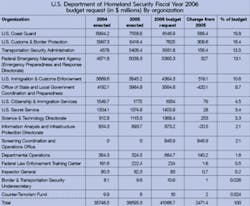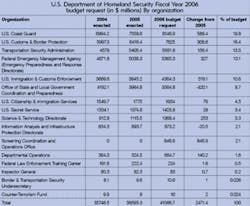By John McHale
WASHINGTON - The U.S. Department of Homeland Security Fiscal Year (FY) 2006 budget request has significant increases for commercial aircraft countermeasures technology and the U.S. Coast Guard Integrated Deepwater System program.
The Counter-Man-Portable Air Defense Systems (C-MANPADS) program was increased by $49 million to $110 million. C-MANPADS researches the viability of technical countermeasures for commercial aircraft against the threat of shoulder-fired missiles.
The Coast Guard’s Integrated Deepwater System increases by $242 million to a total of $966 million in 2006 for the Maritime Security Cutter-Large, complete design of the Maritime Security Cutter-Medium, promote completion of the Multi-Mission Cutter Helicopter (reengineered and electronically upgraded HH-65 helicopter), and improve fixed and rotary wing aircraft capabilities.
The DHS budget request has a total of $41.1 billion, which is an increase of 7 percent over the enacted 2005 funding, excluding Project BioShield, DHS officials say. Money appropriated for BioShield in 2005 is part of an advance appropriation available for obligation through 2008.
The DHS budget request is also filled with other opportunities for electronics suppliers in the private sector.
In fact, analysts at the Civitas Group in Washington in their report, The FY 2006 Homeland Security Budget Request: Key Implications for the Private Sector, estimate that $9.5 billion will be available to private business in the 2006 budget request, a 2.8 percent increase over 2005. The Civitas Group acts as a liaison between the government and the private sector on homeland security.
“Investment in leading-edge technology remains strong, with a double-digit increase in private sector opportunities within the Science and Technology (S&T) Directorate for the second straight year,” the report states. Departments such as S&T Directorate are “finally approaching the capacity to spend all the funds that they were appropriated,” Civitas analysts note. “In 2006, DHS seeks to consolidate research activities within the S&T directorate in the amount of $127 million, which will bring the scientific and engineering personnel and other research resources of the department under one authority. “Heavy electronic areas of the 2006 DHS budget request include the Container Security Initiative (CSI) and America’s Shield Initiative (ASI).”
The Container Security Initiative (CSI) will fund Customs & Border Protection (CBP) department targeting systems, which aid in identifying high-risk cargo and passengers. The budget includes $28.3 million for these system initiatives, which is a $5.4 million increase.
America’s Shield Initiative (ASI) enhances electronic surveillance capabilities along the northern and southern land borders of the U.S. by improving the sensor and video surveillance equipment deployed to guard against the entry of illegal aliens, terrorists, weapons of mass destruction (WMDs) and contraband into the U.S. The budget includes $51.1 million, an increase of $19.8 million.
Other electronics funding requests include:
- $44.2 million in the CBP budget for Long Range Radar technology of the Office of Air and Marine Operations to detect and intercept aircraft attempting to avoid detection while entering the U.S.;
- $19.9 million is for the Armed Helicopter for Homeland Security Project, which increases by $17.4 million to establish armed helicopter capability at five Coast Guard Air Stations;
- $20.5 million for the Office of Interoperability and Compatibility (OIC) within the S&T Directorate for communications equipment and training;” $10 million for replacement of the Coast Guard’s High Frequency (HF) Communications System, which will replace unserviceable, shore-side, high power high frequency transmitters;
- $101 million for the Rescue 21 project to continue recapitalizing the Coast Guard’s coastal zone communications network;
- $20 million for a Low Volatility Agent Warning System, a system that will serve as the basis for a warning and identification capability against a set of chemical agents whose vapor pressure is too low to be detected by conventional measures;
- $73.3 million for Cyber Security to augment a 24/7 cyber threat watch, warning, and response capability that would identify emerging threats and vulnerabilities and coordinate responses to major cyber security incidents;
- $174 million to complete installation of High Speed Operational Connectivity (Hi-SOC) to passenger and baggage-screening checkpoints to improve management of screening system performance;
- $37 million for the Homeland Secure Data Network (HSDN), which will streamline and modernize the classified data capabilities in order to improve classified data communication and collaboration;
- $61.1 million for the Homeland Security Operations Center (HSOC) - this includes an increase of $13.4 million for the Homeland Security Information Network (HSIN) and an increase of $12.9 million to enhance HSOC systems and operations; and
- $43.7 million for emerging checkpoint technology to direct additional resources to improve checkpoint explosives screening. “The 2006 budget also would establish the Domestic Nuclear Detection Office (DNDO) interdict nuclear weapons or materials intended for illicit use. The DNDO will have staffing from DHS, the Department of Energy, the Department of Defense, and the FBI, with coordination between the Department of Justice, Department of State, intelligence community, and other departments as needed.
WMD-detection technology will be an important part of the DNDO strategy. The budget includes $125 million to purchase Radiation Portal Monitors (RPMs) and pilot advanced next generation RPMs to detect gamma and neutron radiation at U.S. borders.




